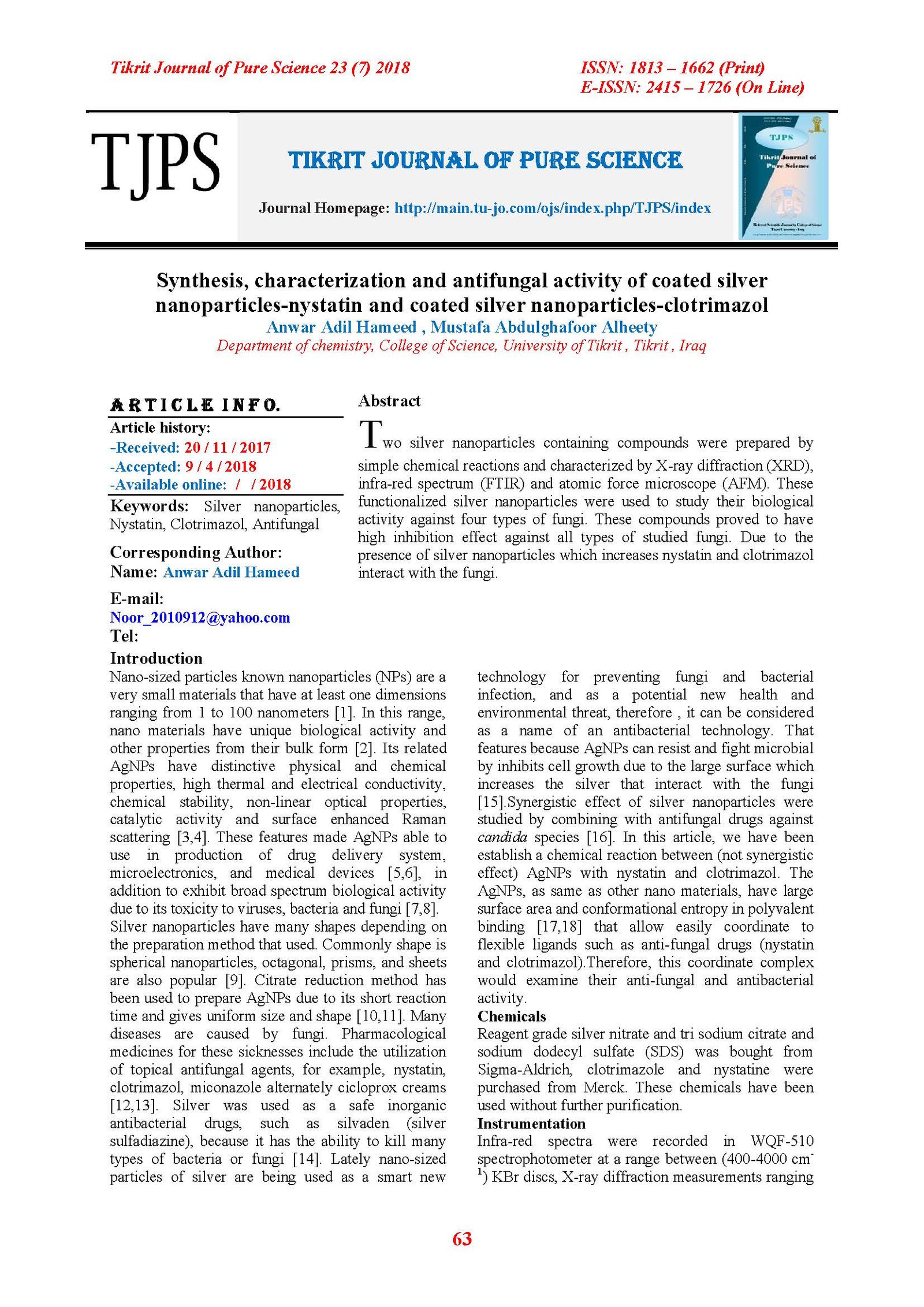Synthesis, characterization and antifungal activity of coated silver nanoparticles-nystatin and coated silver nanoparticles-clotrimazol
Main Article Content
Abstract
Two silver nanoparticles containing compounds were prepared by simple chemical reactions and characterized by X-ray diffraction (XRD), infra-red spectrum (FTIR) and atomic force microscope (AFM). These functionalized silver nanoparticles were used to study their biological activity against four types of fungi. These compounds proved to have high inhibition effect against all types of studied fungi. Due to the presence of silver nanoparticles which increases nystatin and clotrimazol interact with the fungi.
Article Details

This work is licensed under a Creative Commons Attribution 4.0 International License.
Tikrit Journal of Pure Science is licensed under the Creative Commons Attribution 4.0 International License, which allows users to copy, create extracts, abstracts, and new works from the article, alter and revise the article, and make commercial use of the article (including reuse and/or resale of the article by commercial entities), provided the user gives appropriate credit (with a link to the formal publication through the relevant DOI), provides a link to the license, indicates if changes were made, and the licensor is not represented as endorsing the use made of the work. The authors hold the copyright for their published work on the Tikrit J. Pure Sci. website, while Tikrit J. Pure Sci. is responsible for appreciate citation of their work, which is released under CC-BY-4.0, enabling the unrestricted use, distribution, and reproduction of an article in any medium, provided that the original work is properly cited.
References
1.British Standards Institution (BSI). (2007)., PAS136 Terminology for nanomaterials. Accessed from the website: http://www.bsiglobal.com.
2.Sharma V.K., Yngard R.A., Lin Y. Silver nanoparticles: Green synthesis and their antimicrobial activities. Advances in Colloid and Interface Science. (2009);145(1-2):83-96.
3-Tran QH, Nguyen, Van Quy, Le, Anh-Tuan. Silver nanoparticles: synthesis, properties, toxicology, applications and perspectives. Advances in Natural Sciences: Nanoscience and Nanotechnology. (2013); 4 (3): 033001.
4.Krutyakov Y.A., Kudrinskiy A.A., Olenin A.Y., Lisichkin G.V., Synthesis and properties of silver
nanoparticles: advances and prospects. Russian Chemical Reviews.(2008);77(3):233-57.
5.Monteiro D.R., Gorup L.F., Takamiya A.S., Ruvollo-Filho A.C., Camargo E.R., Barbosa D.B., The growing importance of materials that prevent microbial adhesion: antimicrobial effect of medical devices containing silver. International Journal of Antimicrobial Agents. (2009);34(2):103-10.
6Mahakalkar A.B.H., Biophysicochemical Characteristics & Applications of Nanoparticles: Mini Review. American Journal of Drug Delivery and Therapeutics. (2014);1:035-41.
7. Singh R., Nalwa H.S., Medical applications of nanoparticles in biological imaging, cell labeling, antimicrobial agents, and anticancer nanodrugs. Journal of biomedical nanotechnology. (2011); 7(4):489-503.
8.Garnett M.C., Kallinteri P., Nanomedicines and nanotoxicology: some physiological principles. Occ. Med. (2006); 56:307-311.
9. Christina G., Dirk V. L.J., Arnou I. Alfons B., A General Method To Coat Colloidal Particles with Silica”. Langmuir. (2003), 19 (17): 6693–6700.
10.Sebastian W., Kudelski A. “Influence of Oxygen on the Process of formation of Silver Nanoparticles during Citrate/borohydride Synthesis of Silver Sols., Colloids and Surfaces A: Physicochemical and Engineering Aspects, (2012), 410, 20, 45-51.
11.Song K. C., Lee S. M., Park T. S., Lee B. S.. “Preparation of colloidal silver nanoparticles by chemical reduction method”. Korean J. Chem. Eng. (2009), 26 (1): 153–155.
12.Sarsar V., Krishan K., Manjit K.S., Nanosilver: Potent antimicrobial agent and its biosynthesis: review, African Journal of Biotechnology, (2014), 13(4), 546-554, 22.
13.VandenBossche, H., Willemsens, G., Marichal, P., Cods, W., Lauwers, W., The molecular basis of the antifungal activities of N-substituted azole derivatives. Symposia of the British Mycological Society, (1983) 9, 321–341.
14.Marx, John; Walls, Ron; Hockberger, Robert, Rosen’s Emergency Medicine - Concepts and Clinical Practice. Elsevier Health Sciences. (2013), 814. ISBN 1455749877.
15.Chun-Wah M. Y., Joanne Y., Liwei L., Kevin C., Chi-Wai K., Hing-Cheong C., Shuk-Yan C. Chitosan microcapsules loaded with either miconazole nitrate or clotrimazole prepared via emulsion technique, Carbohydrate Polymers (2012), 89, 795– 801.
16.Mehraban F., Shima N., Ayesheh M., Zeinab G., Sanam N. , Mehrdad A., Comparison of antifungal effect of nanosilver particles alone and in combination with current drugs on candida species isolated from women with recurrent vulvovaginal candidiasis, European Journal of Experimental Biology, (2014), 4(1):77-82.
17.Shi Z., Neoh K. G., Kang E. T., Surface-Grafted Viologen for Precipitation of Silver Nanoparticles and Their Combined Bactericidal Activities. 2004 Langmuir 20 6847–52
18. Choi H. J., Han S. W., Lee S J, Kim K., Structure and thermal behavior of a layered silver hydroxyalkanecarboxylate. J. Colloid Interface Sci. (2003), 264 458–66
19.Wulandari P., Nagahiro T., Fukada N., Kimura Y., Niwano M., Tamada K.. Characterization of citrates on gold and silver nanoparticles. Journal of Colloid and Interface Science, (2015), 438, 244-248.
20.Jyoti K., Baunthiya M., Singh A., Characterization of silver nanoparticles synthesized using Urtica dioica Linn. leaves and their synergistic effects with antibiotics, J Radiat Res Appl Sci (2016), 92: 17-227.
